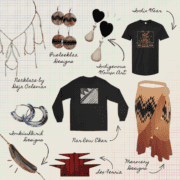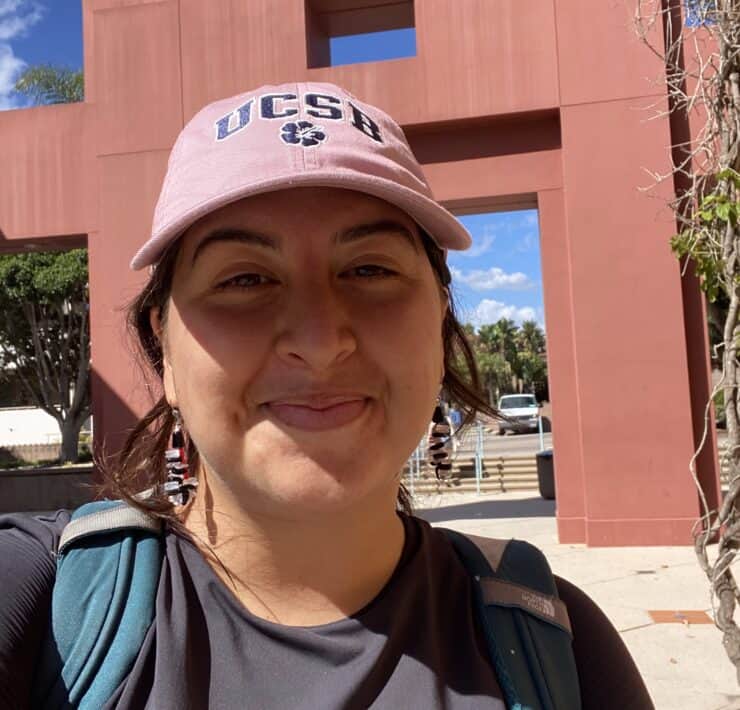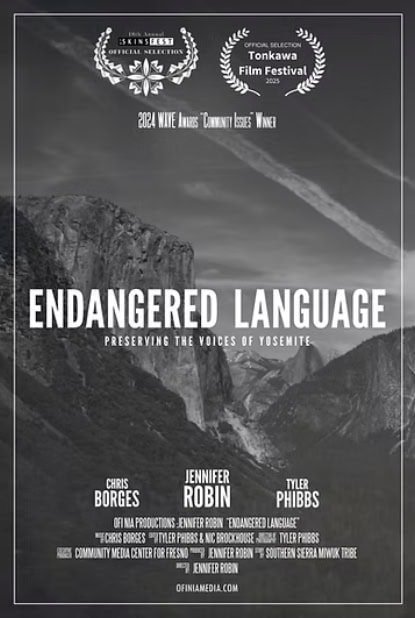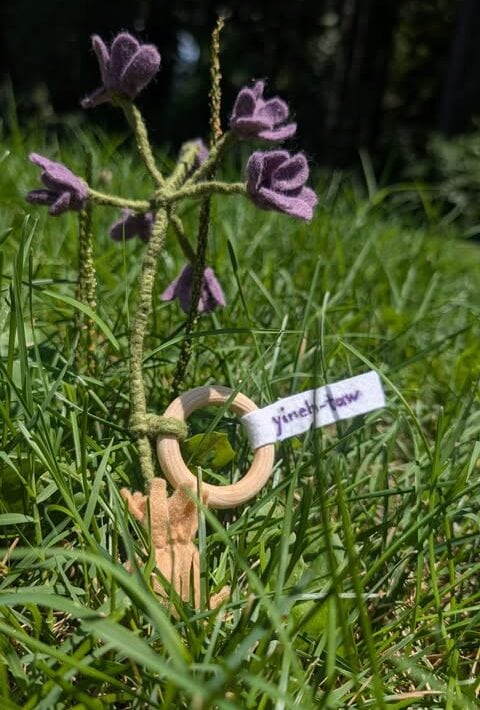Meet 2024 Graton Heyday Berkeley Roundhouse Writing Intern, Muriel Ammon
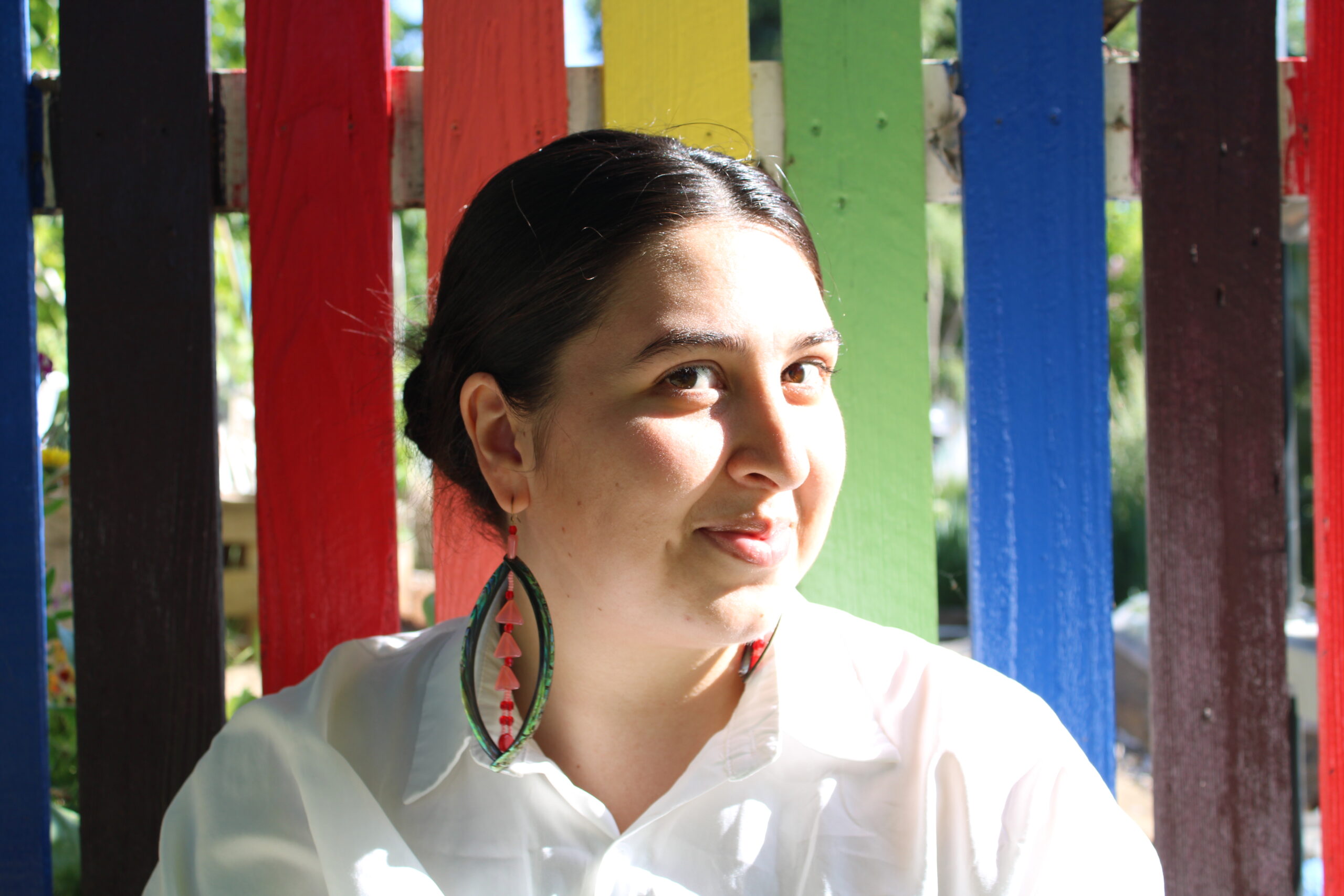
By Muriel Ammon
He:yung, Xosa:k’ wholye.
Hi, my name is Muriel Xosa:k’ Ammon. In Hupa language, xosa:k’ means “abalone.” To my parents, it is a cultural marker of our young women’s coming of age ceremony, the Flower Dance. It’s the glimmer of the beads in the firelight and the unmistakable clink of the pretty shells as someone walks by. It is the scope through worlds that the kinahłdung, Flower Dance girl, will look through in the final moments of her transition to young womanhood. They named me this in hopes that one day I would be a kinahłdung.
In the summer of 2012, I became a Flower Dance girl. My family, friends, and extended community worked for years to revive this ceremony in our village, Łe:lding. Entering my new stage of life, I was bonded to people and practices who would later help me take care of myself, in a good way. I spent my young adulthood dancing in ceremony with Hupa, Yurok, and Karuk neighbors, in orchestra and ballet rehearsals, and studying Native American studies and linguistics at Dartmouth. As soon as I left home, I missed everything, language especially. I then entered a Hupa language Master-Apprenticeship Program (MAP) with my dad. Our language circle expanded, and I had the opportunity to teach young children in camps and a language immersion nest.
Whita’ ‘a:xolye’ Danny Ammon.
My dad’s name is Danny Ammon. Typical Native dad–style, he’s the one everyone knows. I’m constantly bringing him up, just to see if I can cash in some dad points. But it really is one of my favorite things to be stopped mid-sentence and told, “you know your dad and I used to work together.” Our MAP experience reconnected me to people and families that I’d known as a baby, through my dad’s work as a language apprentice or time teaching at DQU. Karuk, Tolowa, Wappo, and Tachi team members became highlights of my MAP experience. I’m so glad AICLS brought our teams together. If there’s one thing I’ve learned, it’s how much of an impact you can create by just getting together.
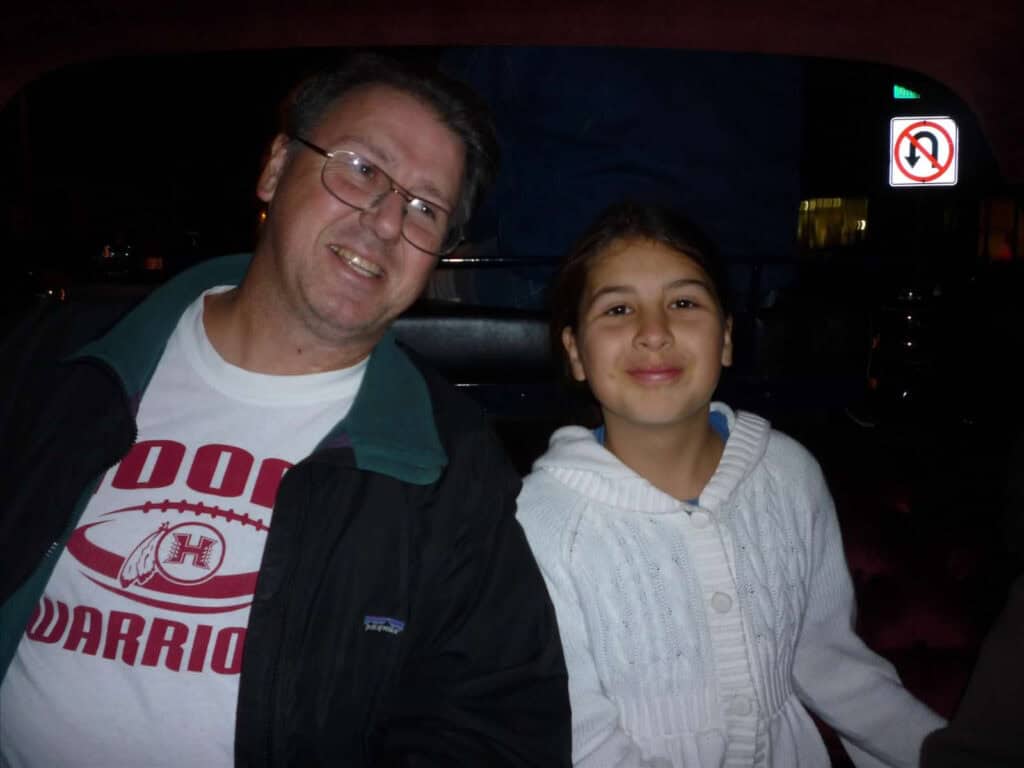
Whunchwing Cassie Nordstrand xolye.
I couldn’t introduce myself without mentioning my mom. She’s a twin. While she was growing up Hopi in Rohnert Park, her mom made a habit of taking her to Indigenous get-togethers, particularly art shows, to have a sense of community. My grandma’s also a hippie, so they enjoyed the reggae scene, foraging for materials to dye wool, and alternative education when available. Eventually, of course, she went to Stanford, studied computer science, and met my dad. When they moved up to Willow Creek in the 1990s, internet was not really a thing. She switched careers, by this fluke, and ultimately found her life’s calling as a Montessori teacher. Her work inspires me, so much so that I completed a Montessori training program with the Indigenous Montessori Institute and the Southwest Institute of Montessori Studies. Just as my dad did everything he could to share the best parts of being Tsnungwe with me, my mom took the initiative to raise me as someone who knows exactly where she comes from.
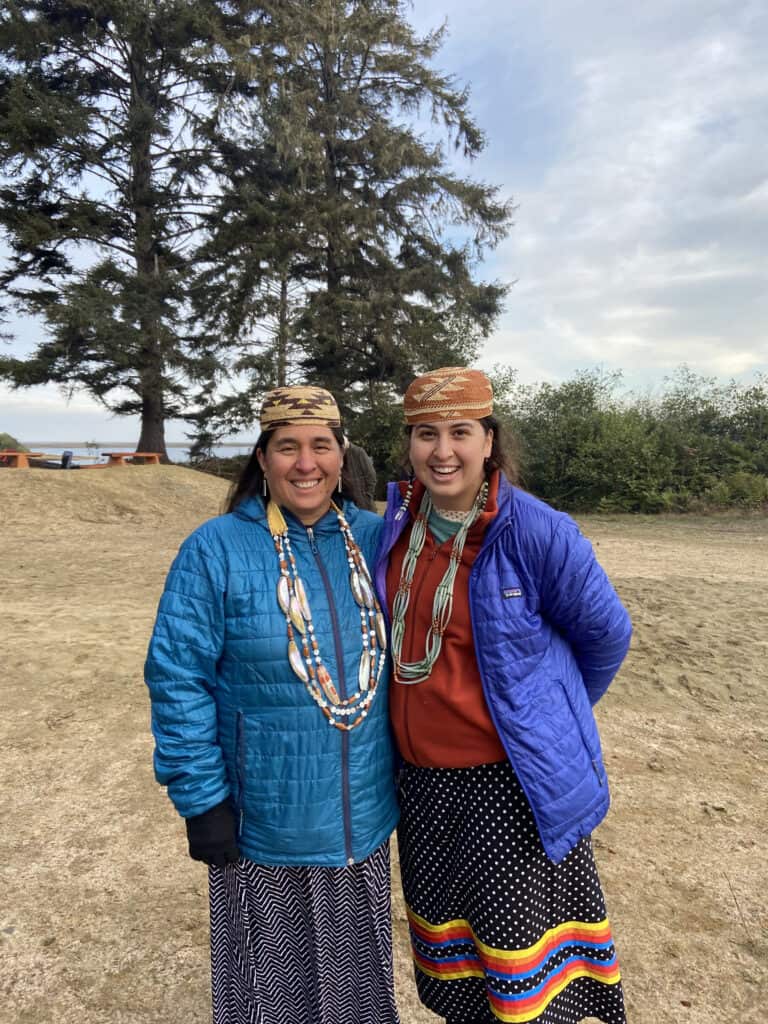
Muriel and mom, Cassie.
Łe:ldimił.
I am from Łe:lding. My village sits at the confluence of the South Fork and the Trinity River, below Friday Ridge, connecting to an expansive mountain range. If you could push a couple mountains aside, you’d see Tse:ning-ding, Ironside Mountain, namesake of my people, the Tse:ning-xwe. I grew up there, with my family close by. We’ve enjoyed summer swims with bellies full of blackberries, acorn gathering up the road, frosty mornings cozied by a woodstove, and the lush green from spring rains. My best friend and cousin, Q’ayliwh, was always running around with me. We thought we were just having fun. It’s important work to be a kid. I’m sure we picked k’inint’ik, wild tea, and tore it into tiny pieces, getting the smell all over our hands. Now that smell immediately elicits a memory of Q’ayliwh’s grandma’s house. We are lucky to have such a deep relationship to our ancestral home. Together, we will always take care of this place.
Tsumehstł’o:n ‘a:wht’e
I am a Tsnungwe woman. Julian Lang, Karuk language master speaker, recently called me asiktáavan, “woman,” rather than “young woman.” I ran to my friend Tori, and we grieved the impending loss of our identities as young women. It’s a joyful time as well. Recently, I found out about the Graton Heyday Berkeley Roundhouse Writing Internship. Immediately, this became my dream job. I was so excited at the prospect of working on News from Native California, the magazine with the beautiful covers filled with stories about my friends. It would be an opportunity to meet more California Natives, hear about the issues near and dear to their hearts, and share what they are doing about it.

Muriel will be writing for the Heyday Berkeley Roundhouse for the 2024-25 year.
Hayi-heh, de:d me:nundiyay, Graton Heyday Berkeley Roundhouse Writing Intern sehłchwin-te. Hay mił whinist’e’ xoniwh.
I got the job!!
The first thing I did was look back through the News from Native California archives. My uncle Bob Benson equipped me with a box of publications spanning from 1987 to 2010. It was like listening to your favorite elders going down memory lane. Stories about my friends and their friends, so young! A treasure trove of pictures. Bob told me he goes through them periodically. There’s always something that didn’t quite catch him the first time—a Brian Tripp piece, a story of Mount Shasta—that ends up being the key to a puzzle or inspiration for his latest artistic endeavor. Reading through, I felt it too. Every publication had a story I could relate to. News from Native California looks and feels like the best parts of home. Spanning the collection were pieces regarding ever-current issues, like the desecration of the Ohlone shellmounds, that were some of the most informative pieces of writing I’ve consumed. Scattered throughout were time capsules, like an ad for the first screening of Smoke Signals, revealing where we were on the Native Californian cultural timeline.
I’m so grateful to have an opportunity to work with the Heyday team, especially my new mentor Terria Smith. I can’t wait to learn the behind-the-scenes of News from Native California, and look forward to being connected with neighboring tribal communities. I invite you to reach out to me through email at muriel@heydaybooks.com. Ts’ehdiyah! Thank you, woohoo!
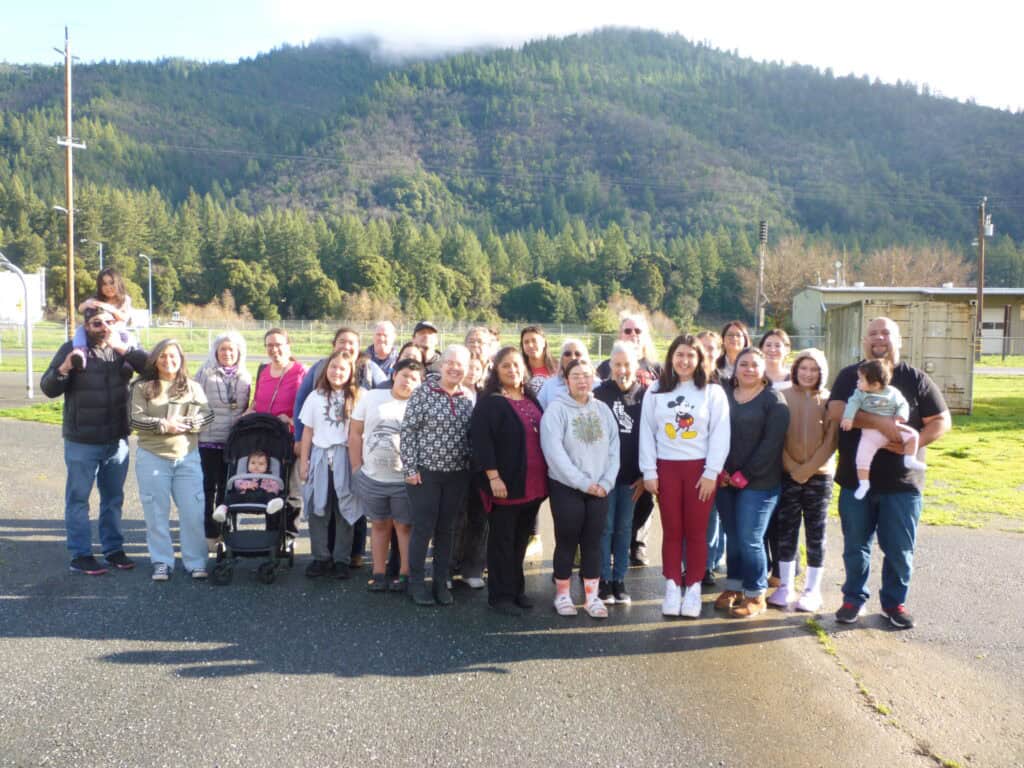
Muriel with the Advocates for Indigenous California Language Survival.


